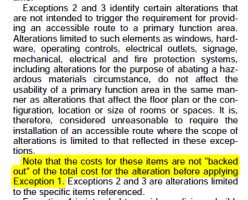Tim Mailloux
REGISTERED
I have a client who is moving into a building that poses significant accessibility challenges. This client operates a manufacturing facility specializing in custom high-end metal finishing. From a cost perspective, the majority of the project scope involves major electrical and HVAC upgrades to the proposed manufacturing floor, which is the area containing the facility's primary function.
Upon reviewing IEBC 306.7.1 exception #3, it seems that one could infer that $700k to $800K in electrical and HVAC upgrades might not count against the '20% rule'. However, I am uncertain if this interpretation is accurate. If these upgrades were general electrical and HVAC renovations to repair or refresh the existing systems in the building, that would be one thing. However, without these extensive upgrades, the intended primary function of the facility would not be possible. My gut feeling is that the costs of these upgrades should apply to the 20% rule.
Additionally, the remainder of the construction scope is quite limited, involving partial height wall construction. It's important to note that the existing building does not have an accessible entrance or any accessible toilets. Unfortunately, 20% of the hardwall construction cost would not cover improvements to either of these conditions.
Given these considerations, I would appreciate your input and clarification on whether the costs of the electrical and HVAC upgrades should indeed be counted towards the 20% rule
306.7.1 Alterations affecting an area containing a primary function.
Where an alteration affects the accessibility to, or contains an area of primary function, the route to the primary function area shall be accessible. The accessible route to the primary function area shall include toilet facilities and drink-ing fountains serving the area of primary function.
Exceptions:
1. The costs of providing the accessible route are not required to exceed 20 percent of the costs of the alterations affecting the area of primary function.
2. This provision does not apply to alterations limited solely to windows, hardware, operating controls, electrical outlets and signs.
3. This provision does not apply to alterations limited solely to mechanical systems, electrical systems, installation or alteration of fire protection systems and abatement of hazardous materials.
4. This provision does not apply to alterations under-taken for the primary purpose of increasing the accessibility of a facility.
5. This provision does not apply to altered areas limited to Type B dwelling and sleeping units.
Upon reviewing IEBC 306.7.1 exception #3, it seems that one could infer that $700k to $800K in electrical and HVAC upgrades might not count against the '20% rule'. However, I am uncertain if this interpretation is accurate. If these upgrades were general electrical and HVAC renovations to repair or refresh the existing systems in the building, that would be one thing. However, without these extensive upgrades, the intended primary function of the facility would not be possible. My gut feeling is that the costs of these upgrades should apply to the 20% rule.
Additionally, the remainder of the construction scope is quite limited, involving partial height wall construction. It's important to note that the existing building does not have an accessible entrance or any accessible toilets. Unfortunately, 20% of the hardwall construction cost would not cover improvements to either of these conditions.
Given these considerations, I would appreciate your input and clarification on whether the costs of the electrical and HVAC upgrades should indeed be counted towards the 20% rule
306.7.1 Alterations affecting an area containing a primary function.
Where an alteration affects the accessibility to, or contains an area of primary function, the route to the primary function area shall be accessible. The accessible route to the primary function area shall include toilet facilities and drink-ing fountains serving the area of primary function.
Exceptions:
1. The costs of providing the accessible route are not required to exceed 20 percent of the costs of the alterations affecting the area of primary function.
2. This provision does not apply to alterations limited solely to windows, hardware, operating controls, electrical outlets and signs.
3. This provision does not apply to alterations limited solely to mechanical systems, electrical systems, installation or alteration of fire protection systems and abatement of hazardous materials.
4. This provision does not apply to alterations under-taken for the primary purpose of increasing the accessibility of a facility.
5. This provision does not apply to altered areas limited to Type B dwelling and sleeping units.


